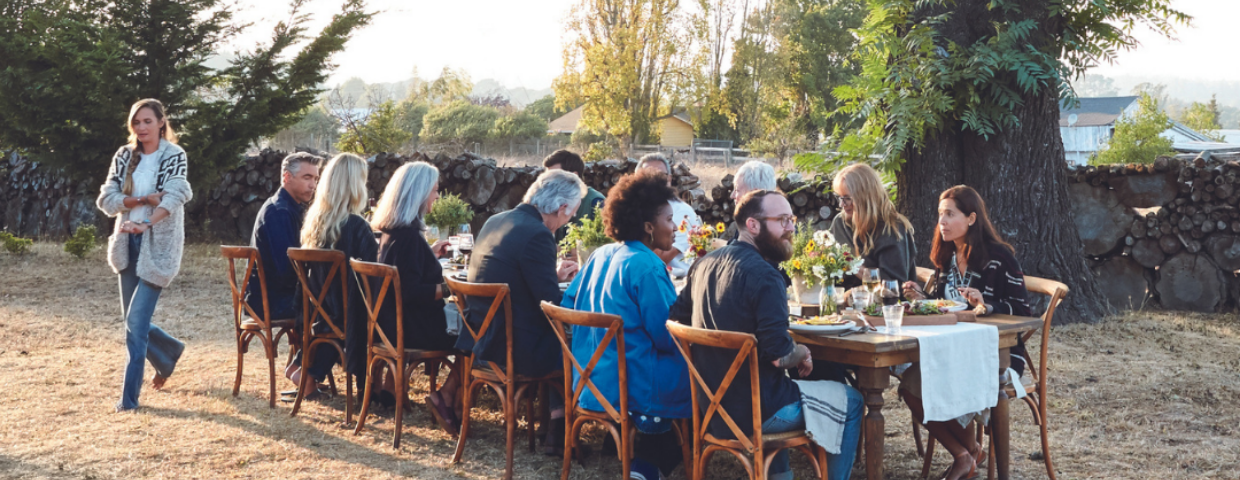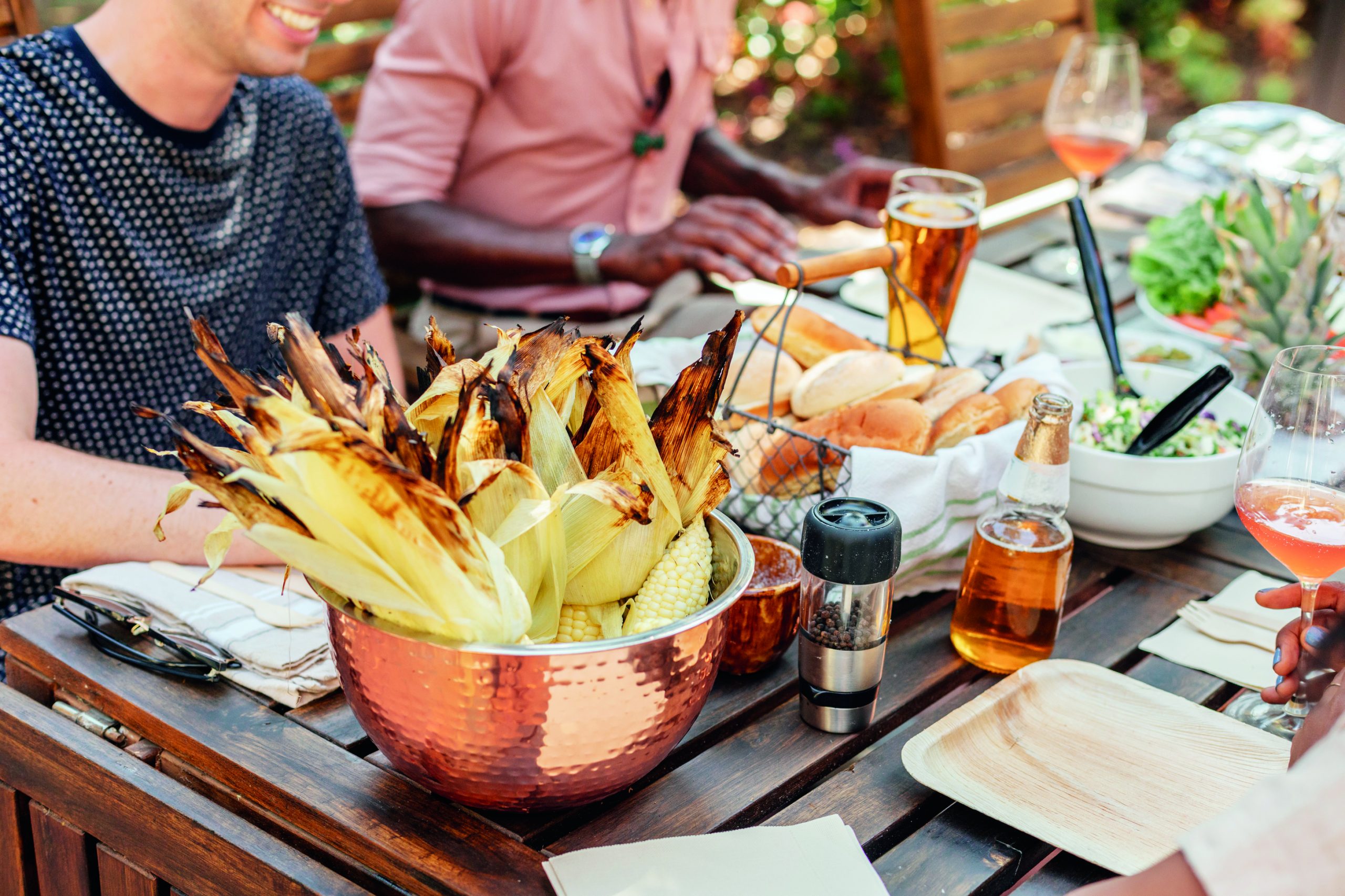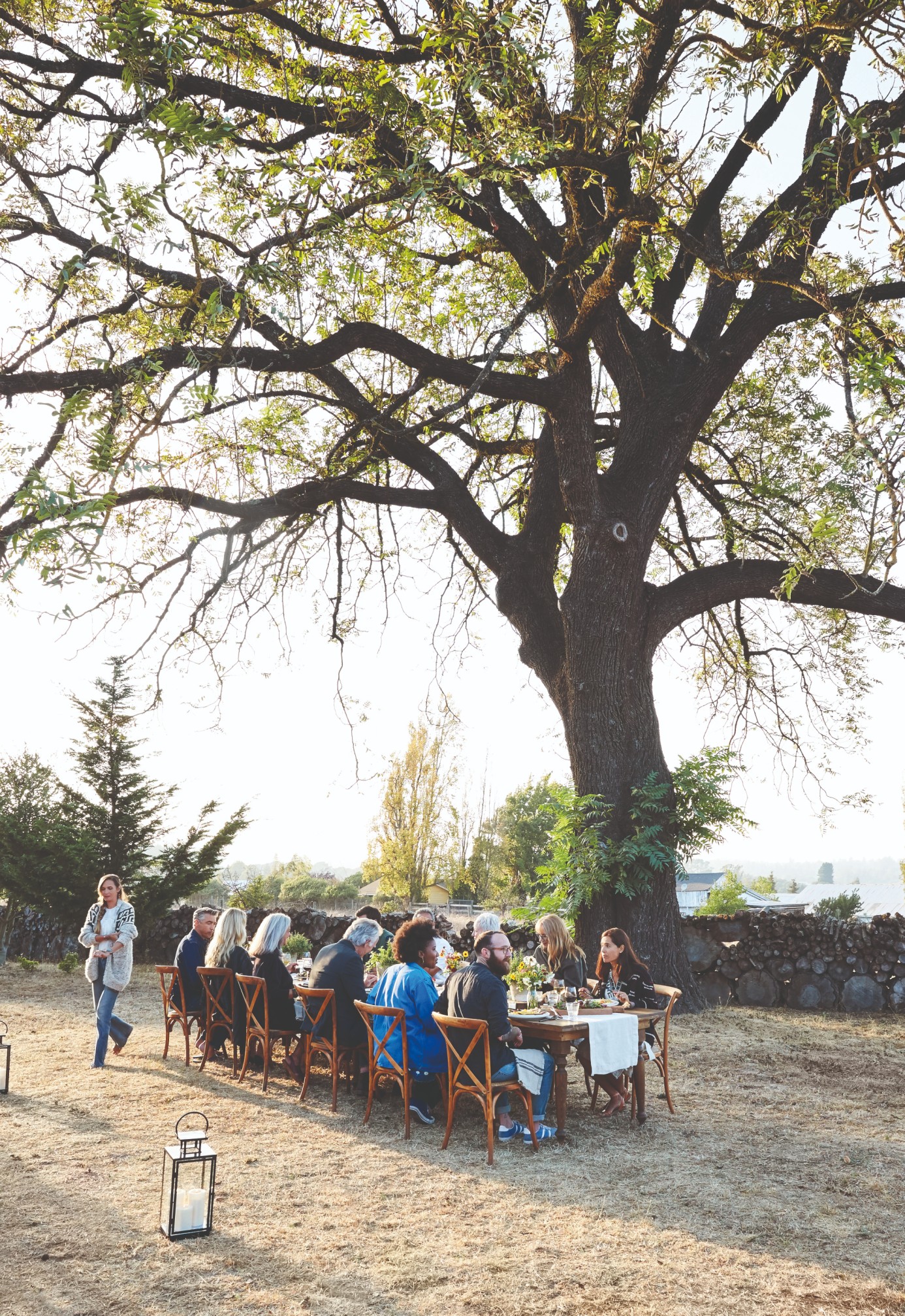Population Math

The brand new Census data has just been released and it is fascinating!
Colorado’s population now sits just below 6 million people at 5.773 million. Just 20 years ago it was 4.301 million.
Northern Colorado is booming and now has 688,047 in Larimer and Weld Counties. It grew by 135,592 people in just ten years. If Northern Colorado grows at just 2% per year, it will have 838,725 people by 2030 and 1,022,402 by 2040.
For several years we have been predicting that Northern Colorado would exceed by 1 million people by 2040 and it looks like that will come true.
Metro Denver is also booming. For reference, we define ‘Metro Denver’ as Adams, Arapahoe, Denver, Douglas, and Jefferson Counties.
Population in Metro Denver is now 2.831 million and was 2.109 million in the year 2000. It has grown by 722,000 people in 20 years.
If Metro Denver grows at 2% per year, it will hit 3.451 million in 10 years and 4.206 million in 20 years.
Charmed Living in Windsor

Live your best life in this Charming Oldtown Bungalow right across from Windsor Main Park. Gorgeous park views! 205 Locust Street is a 3bed/1Bath, open floor plan, beautifully updated kitchen and bath, +bonus room. Kickback on the shaded patio! Backyard boasts mature landscaping, deep grassy lot, ally access and dog run. Enjoy all the charms of downtown living- stroll the park, visit historic museums, hang out with friends at local restaurants and breweries. Windsor Lake and Chimney Park and pool are just a few blocks away! Contact Elizabeth Dolton at (970) 396-7233 to schedule your private tour or click here for more information.
Q2 2021 Colorado Real Estate Market Update

The following analysis of the Metro Denver & Northern Colorado real estate market is provided by Windermere Real Estate Chief Economist Matthew Gardner. We hope that this information may assist you with making better-informed real estate decisions. For further information about the housing market in your area, please don’t hesitate to contact your Windermere Real Estate agent.
REGIONAL ECONOMIC OVERVIEW
Although the post COVID-19 job recovery took a step backward last winter, it has since picked up again, which is very pleasing to see. At the end of the second quarter, the state had recovered more than 276,000 of the 376,000+ jobs that were shed due to COVID-19. Even though employment levels are still almost 100,000 lower than the pre-pandemic peak, they are heading in the right direction. Looking at the markets contained in this report, current employment levels in Colorado Springs are only 2.2% below the pre-pandemic peak, followed by Denver and Fort Collins, which are both down 3.6% from the 2020 peak. I would add that all markets showed jobs continuing to return. With total employment levels rising, the unemployment rate stands at 6.2%, down from the pandemic peak of 12.1%. Regionally, unemployment levels range from a low of 4.8% in Boulder to a high of 6.3% in Grand Junction. COVID-19 infection rates dropped during the quarter, which is certain to lead to employment levels continuing to rise unless we see another significant increase in infection rates due to the rise of new variants across the country.
COLORADO HOME SALES
❱ The late spring/early summer market was a good one for home sales, which were up 33.9% from a year ago. Comparing the current quarter to a period when COVID-19 was widespread is not that informative, but, with sales up more than 55% from the first quarter of this year, the market appears to be very buoyant.
❱ Sales were higher in all counties other than the very small Clear Creek County. Where sales rose, they did so at double-digit rates in all markets other than Weld.
❱ During the second quarter, 13,428 homes sold. This is very impressive but not overly surprising, given that the average number of homes for sale was up 45% from the first quarter.
❱ Another positive was that pending sales, which are an indicator of future closings, were 42.8% higher than in the first quarter. This suggests that closings next quarter should be positive as well.
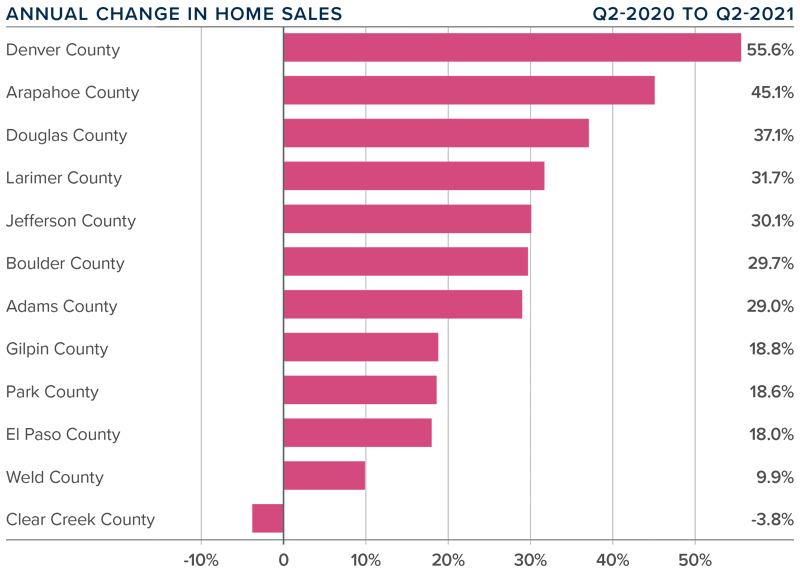
COLORADO HOME PRICES
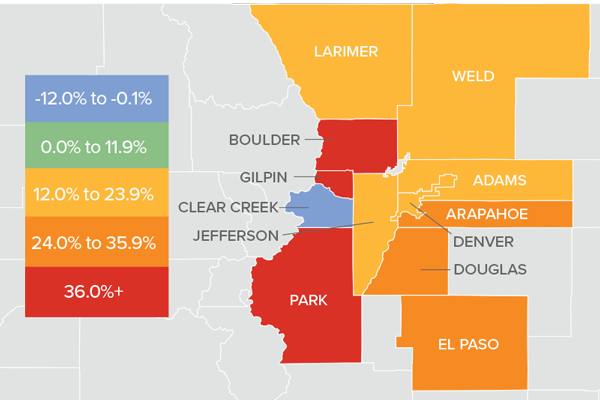
❱ Prices continue to appreciate at an impressive pace, recording an increase of 28.1% year over year to an average of $615,409. Home prices were also 10.7% higher than the first quarter of this year.
❱ Buyer demand remains very strong, likely exacerbated by the drop in mortgage rates in the second quarter and improving levels of inventory.
❱ Year-over-year, prices rose across all markets covered by this report, with the exception of Clear Creek County. Of the markets that saw prices rise, all did so by double digits, with very notable gains in Boulder, Gilpin, and Park counties.
❱ Affordability levels continue to trouble me, and the pace of price appreciation has to slow at some point. The market is clearly still out of balance, but as long as the credit quality of buyers remains high, I do not see any cause for concern.
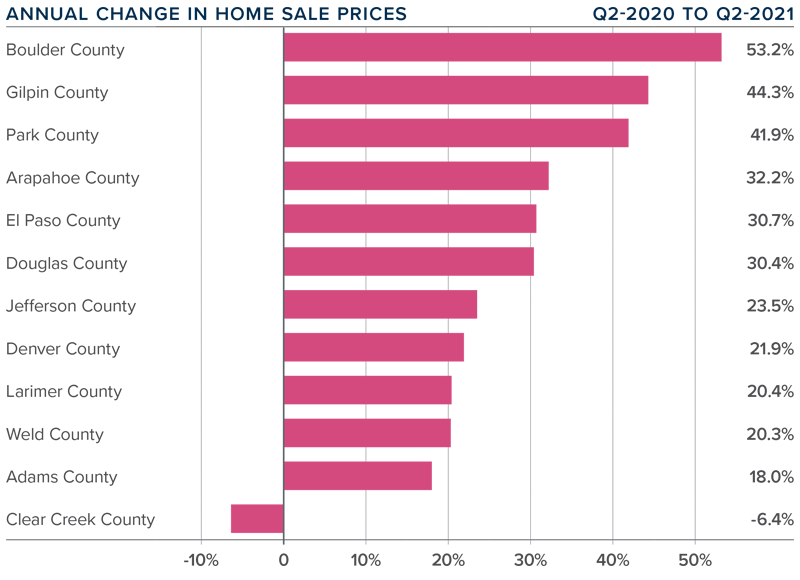
DAYS ON MARKET
❱ The average number of days it took to sell a home in the markets contained in this report dropped 14 days compared to the second quarter of 2020.
❱ The amount of time it took to sell a home dropped in every county contained in this report compared to the second quarter of 2020. The exception was Gilpin County, where it rose by only two days.
❱ It took an average of only 14 days to sell a home in the region, which is down 11 days compared to the first quarter of this year.
❱ The Colorado housing market remains very tight, as demonstrated by the fact that it took less than a month for homes to sell in every county other than one.
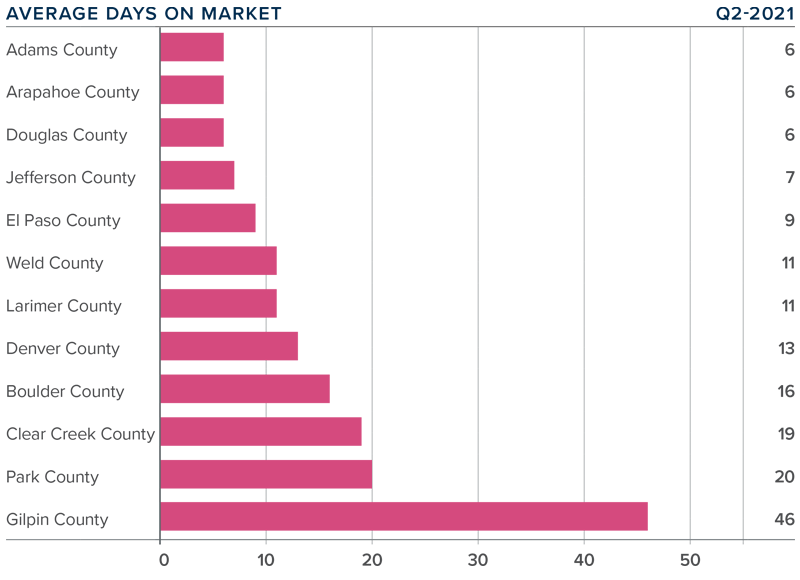
CONCLUSIONS

This speedometer reflects the state of the region’s real estate market using housing inventory, price gains, home sales, interest rates, and larger economic factors.
Sales rose on the back of lower mortgage rates and higher levels of homes available to buy. Although this should signify a move back to a more balanced market, we are not there yet as price growth remains well above the long-term average.
With solid demand and favorable financing rates, the market is expected to remain active as we move through the balance of the year. That said, housing affordability is becoming an increasingly large concern. According to the Colorado Association of REALTORS®, statewide affordability for single-family homes has dropped almost 20% year-over-year and is down 17.8% for multi-family homes.
At some point, an affordability ceiling will be reached, which will slow home-price appreciation—but not yet. As such, I am moving the needle a little more in favor of home sellers, as they remain in the driver’s seat, for now.
ABOUT MATTHEW GARDNER

As Chief Economist for Windermere Real Estate, Matthew Gardner is responsible for analyzing and interpreting economic data and its impact on the real estate market on both a local and national level. Matthew has over 30 years of professional experience both in the U.S. and U.K.
In addition to his day-to-day responsibilities, Matthew sits on the Washington State Governors Council of Economic Advisors; chairs the Board of Trustees at the Washington Center for Real Estate Research at the University of Washington; and is an Advisory Board Member at the Runstad Center for Real Estate Studies at the University of Washington where he also lectures in real estate economics.
100 / 90 / 60

As you’ve probably heard, prices have gone up quite a bit along the Front Range.
Low interest rates, strong demand, lower supply, and a healthy local economy are all contributing to increased prices.
It may interest you to see exactly how much prices have increased since one year ago in the markets where we have the most activity.
Over the last year, Weld County has increased roughly $100,000, Metro Denver $90,000 and Larimer County $60,000.
Specifically, here are the average prices one year ago vs. today:
- Weld County = $426,000 vs. $523,000
- Metro Denver = $523,000 vs. $612,000
- Larimer County = $532,000 vs. $592,000
Windermere Living: Board it Up
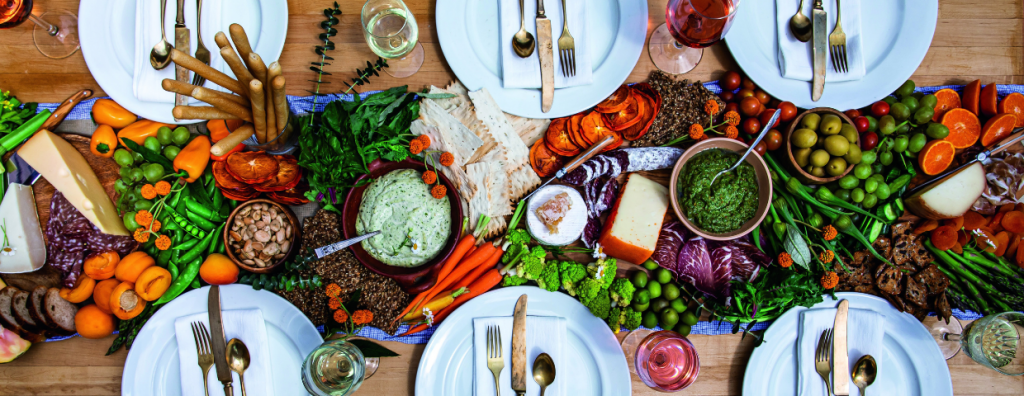
For an intimate gathering or celebration, or just to change up a weeknight dinner, charcuterie boards are impressive crowd-pleasers.
Once an innocuous appetizer, charcuterie boards are stealing the show as stunning smorgasbords studded with salami roses and a rainbow of ripe vegetables, flamboyant fruits, and sweet and savory snacks. Traditionally, charcuterie boards are composed of meats and cheeses—the name even comes from the French for “cooked flesh.” A part of French culinary art since at least the 15th century, they were considered the food of the bourgeoisie for hundreds of years before catching on with higher-end cooks. Now, they return to accessibility as people find ways to customize their boards and feature all sorts of spreads. Trays and wood blocks can be artfully piled with everything needed for a build-your-own brunch buffet, a vegan midday meal, or an elegant soirée starter. Boards tap into a host’s creative side as an easy, fun way to put out an incredible spread that pleases every type of person. “I love making them for entertaining,” says Amy Holt of Peas Thank You in Venice, California, “because it’s a centerpiece for conversation.”
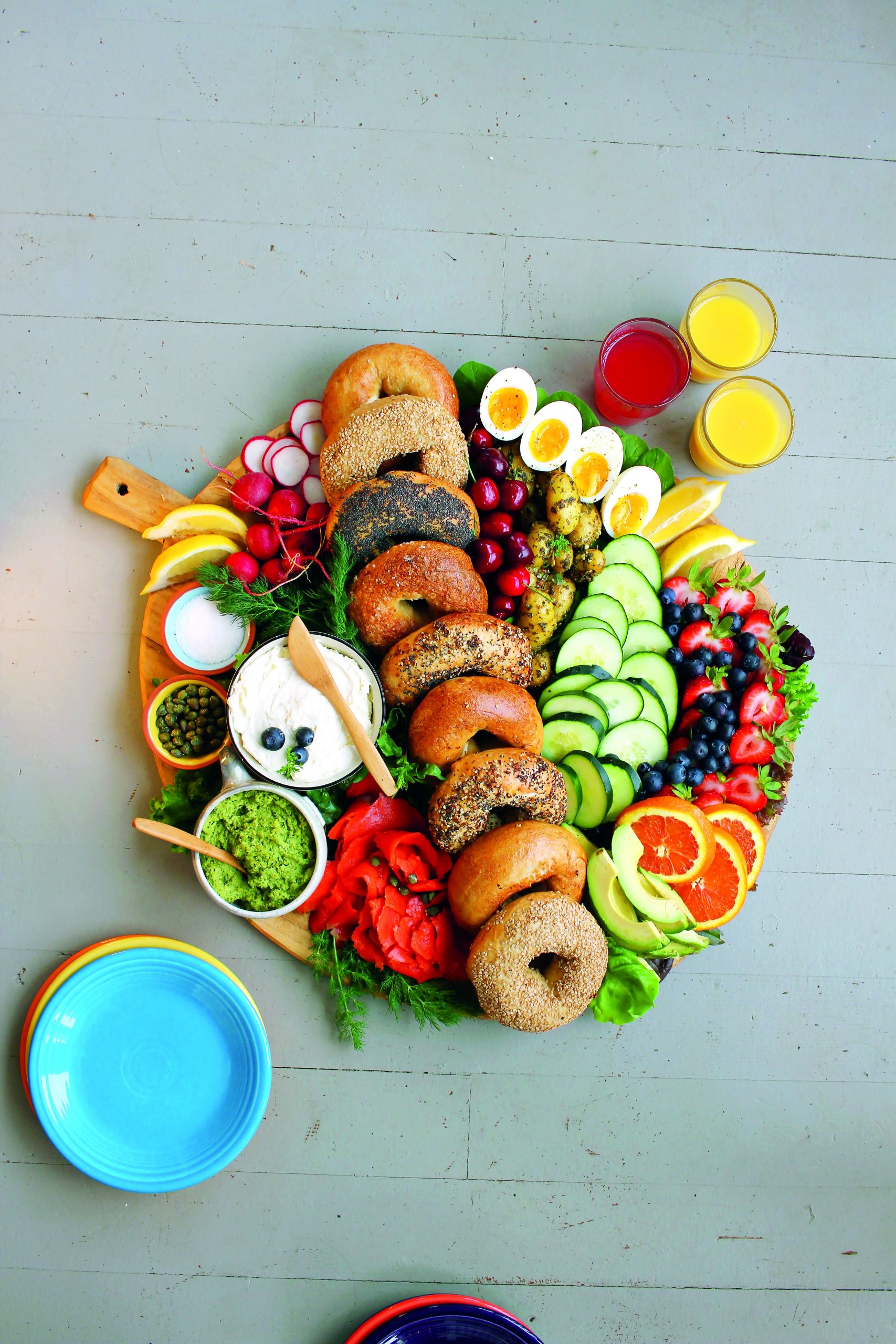
Photography by Carly Diza – Food Styling by Anne Parker
At cocktail parties, casual gatherings, or before a sit-down dinner, charcuterie board–style spreads allow people to create their own bites and discuss what they paired and how they ate it—functioning as both food and icebreaker. The chameleon of catering, boards fit in as easily at a small family picnic as they do at an upscale event, while also giving people more flexibility than a set menu: hungrier guests can make almost a full meal of the offerings, while lighter eaters can sparsely snack. But the ultimate asset of an attractive board to anchor an event is the freedom to indulge artistic whims in building a creative, edible assortment. Expert charcuterie board makers from around the West talk about how they design their signature creative boards with both classic snacks and unorthodox offerings in elegant arrangements for family, friends, and gatherings large and small.
Magnificent Morning
When a client for her charcuterie board business requested a bagel spread for a bar mitzvah, Sylvie Stulic, of the Bay Area’s On the Board Gourmet, saw it as the perfect opportunity to get creative. Now it’s part of her standard offerings, and she’s gained knowledge on the best way to build a bagel board.
Functional Design
The big size and flavor of caperberries always draws wows, says Stulic, while she adds extra brightness with red sweetie drop peppers. “I love to include a floral element,” she says, which may be actual (edible) flowers or cucumbers styled into roses. One standard bagel fixing not found on the bagel boards, though, are onions. “They contaminate the other flavors,” Stulic explains.
Tips of the Tray
Unless the board is enormous, Stulic slices and cuts the bagels in half so that they don’t visually overwhelm everything else. She uses the halves to create a line down the middle and creates symmetry with the colors around it. Aim to keep the bagels surrounded by dry ingredients so they don’t get soggy on the board. For serving a crowd or an event, bagels work well because they are traditionally eaten at room temperature. But at home, she branches out, creating similar breakfast spreads for her family out of crepes, waffles, and pancakes.
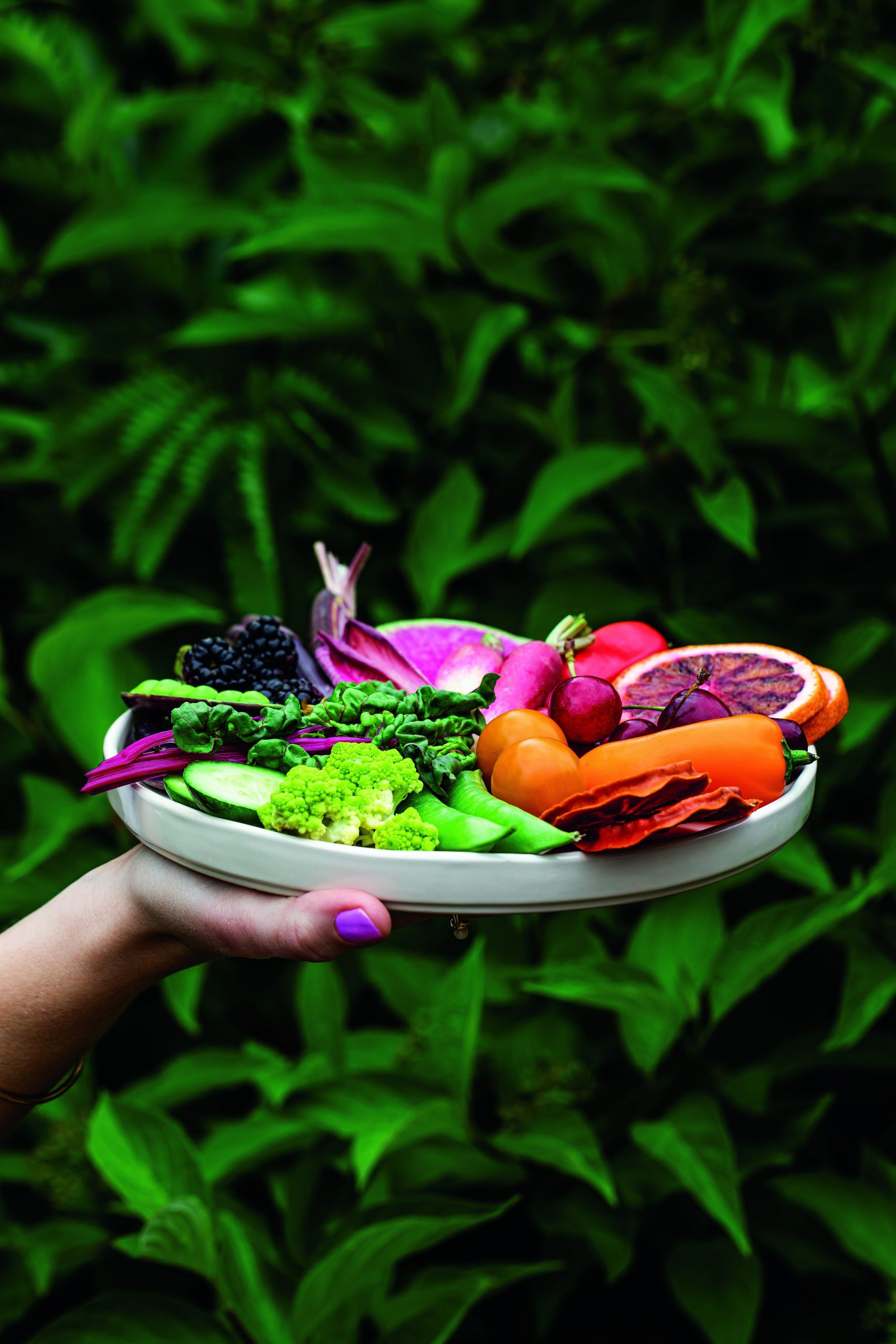
Photography by Carly Diza – Food Styling by Anne Parker
Creative Colors
The rainbow platters made by Amy Holt of Peas Thank You in Venice, California, stand out for their bold use of patterns, whether as a fun fruit display, a vegan snack selection, or a traditional meat and cheese board.
Shop Savvy
“Start at the farmers market,” says Holt. That’s the best place to find natural-looking fruits and vegetables, like radishes with their stems and broccolini with flowers. But even if limited to a grocery store, she can look for the same effect with tomatoes on the vine and celery with nice leaves to use as a garnish. Instead of buying pre-sliced meats or trying to slice them at home—especially for small boards that only need a few slices of each type of meat—Holt uses the deli counter at the grocery store, which will cut them to order. Holt uses honeycomb on cheeses and tops a chia seed pudding with toasted coconut to add special touches.
Tips of The Tray
Bring variety in shapes as well as color by cutting and stacking the food creatively: put berries on a skewer, clip the grape bunches into manageable sizes, and fold the meat in different ways. Start with the biggest things first by plating any dips or spreads. Holt uses a coconut chia seed pudding as the anchor to her fruit boards and hummus on her vegan spread. Arrange foods in groups of three, and always use odd numbers, as they are more naturally pleasing to people. Use triangle formations to direct the eye across platters, drawing attention to the whole board, rather than a single spot or line. Finish by tossing a small, attractive garnish all over the board—berries, little tomatoes, or cilantro flowers—to add a decorative touch.
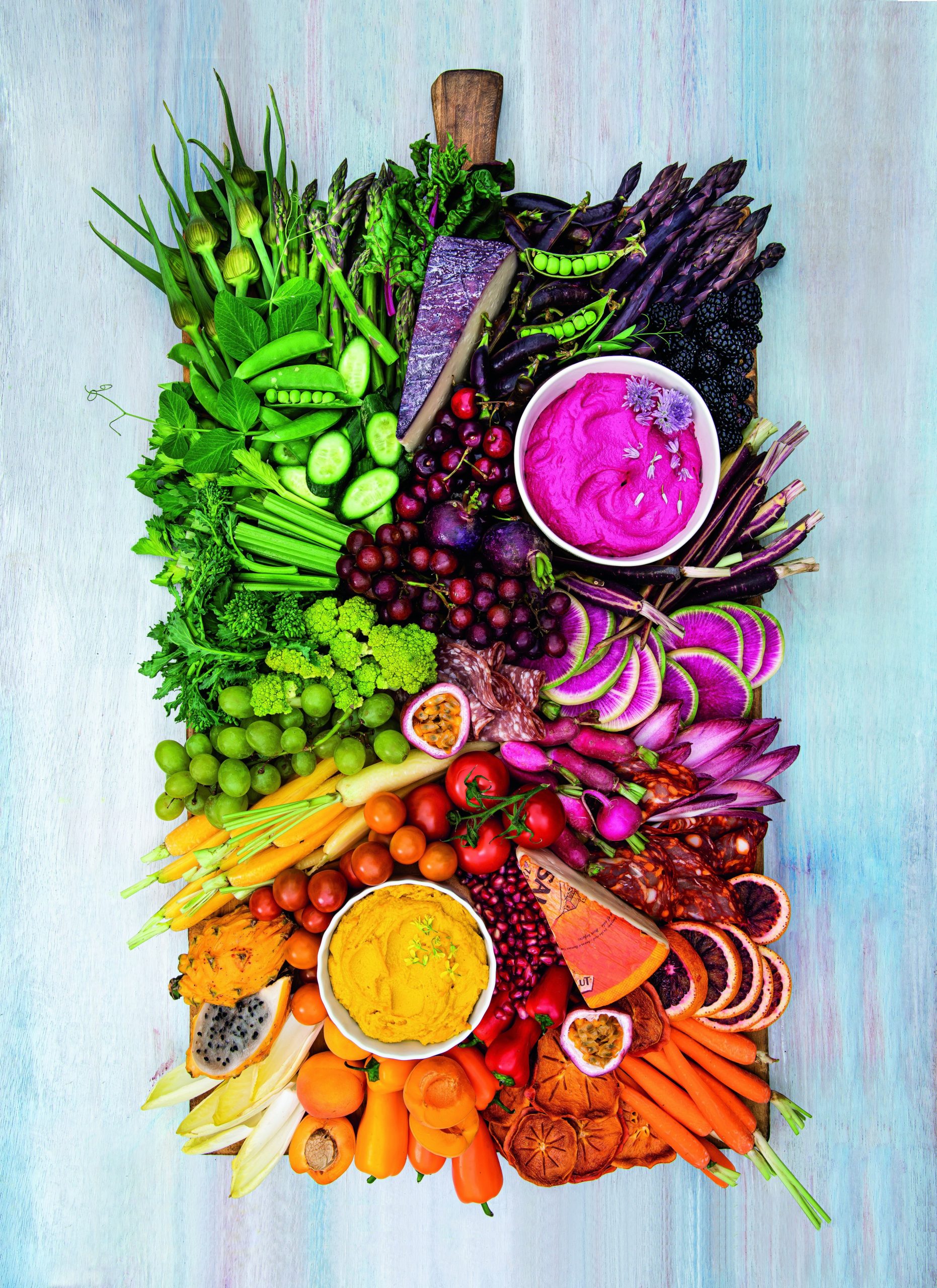
Photography by Carly Diza – Food Styling by Anne Parker
Edible And Upscale
When the fashion industry slowed down during the pandemic and the events Rona Argana once planned dried up, she used her sharp eye for design to craft grazing boxes as gifts to send to her friends. That turned into For Love and Graze, her North Hollywood, California business that spins casual snack platters into eye-catching displays.
Ingredients for Elegance
Use the green color of leaves to signify freshness, says Argana. She likes mint sprigs in the spring, rosemary and sage in the winter. (Keep them well hydrated ahead of time, so they last longer.) Fancy can still be fun, and she loves to use letter-shaped cookie cutters and slices from a log of mozzarella cheese to add celebratory messages. Savory needs a balance of sweet, so even her traditional snack boards always include a sugary nibble like chocolate-covered almonds or yogurt-covered pretzels.
Tips of the Tray
Start by setting out a neutral color palette of the crackers, meats, and cheeses. Then bring in a limited range of colors, sticking to greens, oranges, and reds. Balance each color with multiple tones and items: use both olives and grapes for green and offset the reds from berries with similar shades of citrus. Most of all, Argana says, don’t forget the purpose of the creation, and consider the flavors as much as the colors: “Make sure it tastes as good as it looks.”
Updated Evans Home!
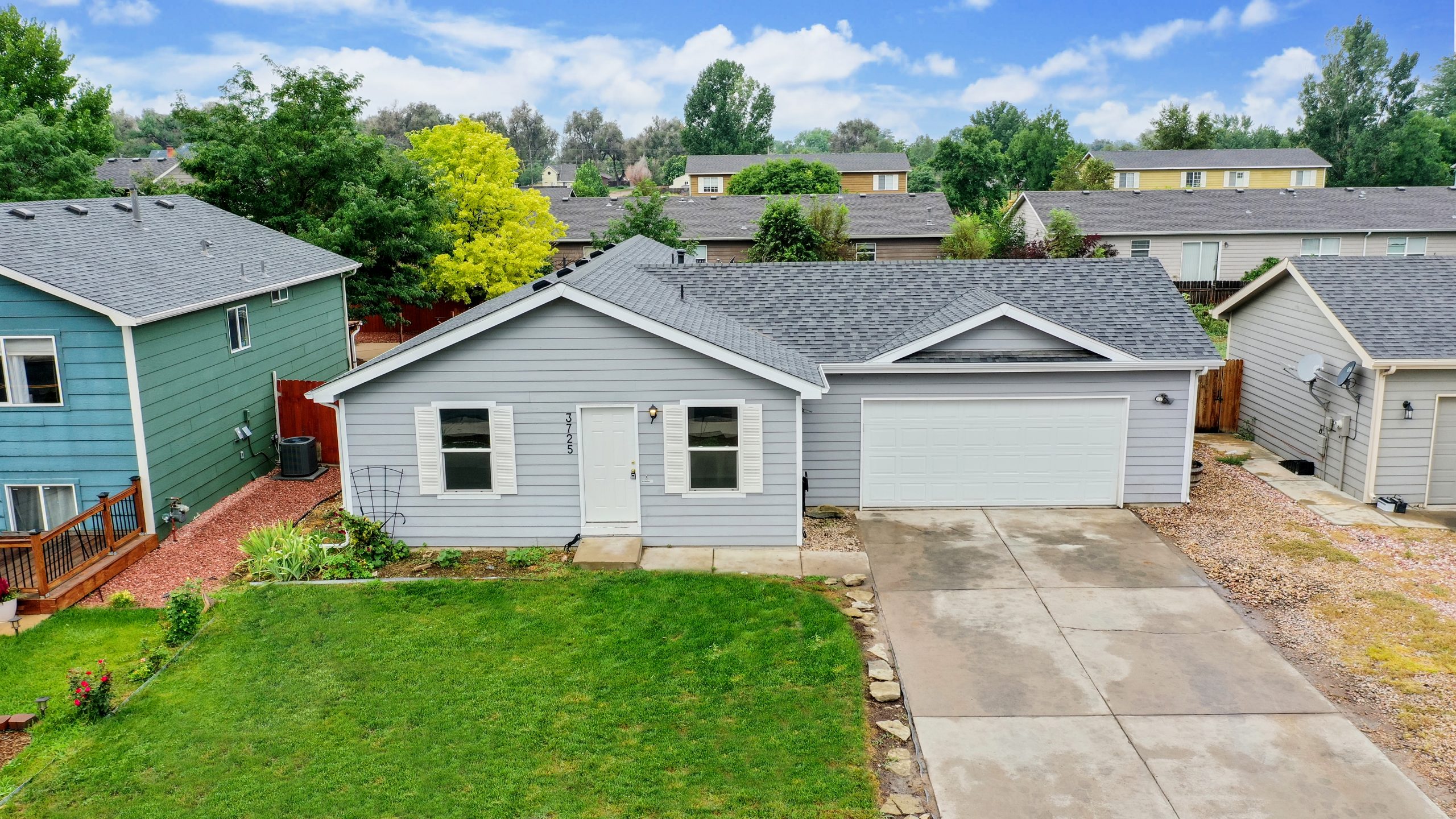
Don’t miss out on this great home! 3725 Riverside Parkway, Evans has new paint and carpet throughout, open living/dining area, newer stainless steel appliances, 3 bed, 2 full baths, large back yard, shed and an oversized 2 car garage. It is has easy access to Highway 85, Highway 34 and shopping. It won’t last long! This home goes live on the MLS on Friday, Aug. 6th and showings will begin Saturday, Aug. 7th at 9:00 a.m. PLEASE SUBMIT ALL OFFERS NO LATER THAN NOON ON THURSDAY, AUG. 12. Contact Angie Clauser at (970) 590-9860 to schedule your private tour or click here for more information.
Severance Gem
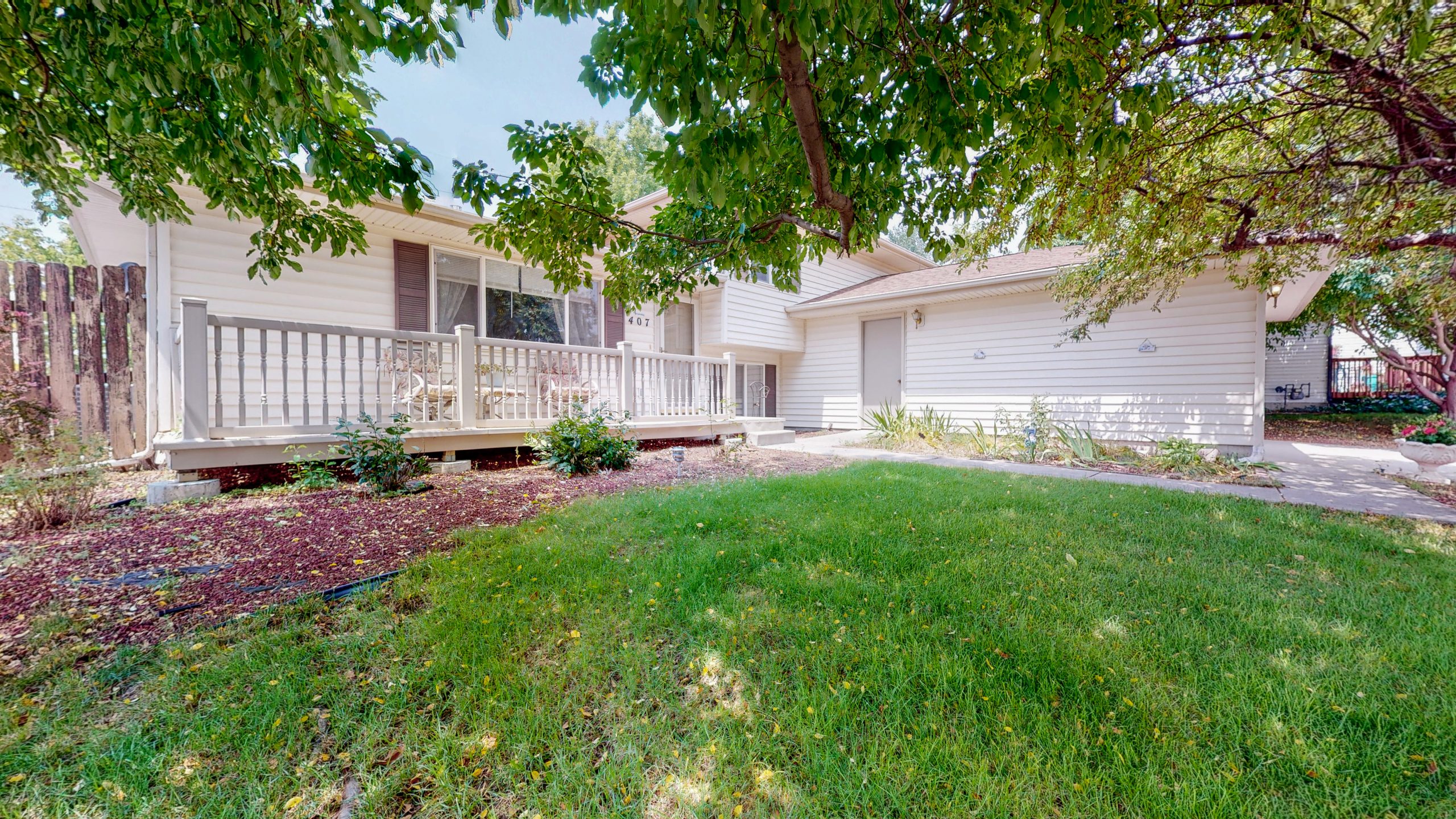
407 Lakeview Drive is a gem in Severance. This split-level home has 4 bedrooms, 3 bathrooms, gas stove, granite counter tops, SS Appliances,2 living room areas, gas fire place, 4 season sun room, open space to the back of the property, mature landscaping, enjoy sitting on the back porch and watching the sunsets, 2 car attached garage, nice sized front porch, NO HOA, NO Metro Tax. Showings start Thursday, 8/5. Great home, will not last long. Contact Suzanne Ekeler at (970) 590-4841 to schedule your private tour or click here for more information.
 Facebook
Facebook
 X
X
 Pinterest
Pinterest
 Copy Link
Copy Link


